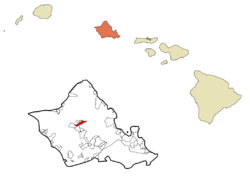Oahu Colony
21°32′09″N 158°01′10″W / 21.535833°N 158.019444°W
Oahu Protectorate
Oʻahu (Hawaiian) | |
|---|---|
 Location of Wahiawa. | |
| Country | North American Confederation |
| Protectorate established | 27 May 2015 |
| Protectorate abolished | 1 July 2018 |
| Capital | Helemano Military Reservation |
| Government | |
| • Governor | Jacob Ramirez (First) Jacob Benning (Last) |
| Area | |
| • Total | 1.036 km2 (0.400 sq mi) |
| Population (October 2015) | |
| • Total | 5 |
| • Density | 4.8/km2 (12/sq mi) |
| Time zone | UTC-10 (Hawaii) |
The Oahu Colony was a colonial area of the North American Confederation in Hawaii, on the island of Oahu. It was located in the Wahiawa District, on the plateau or "central valley" between the two volcanic mountains that comprise the island. The colony was established by the provisional government due to the Imperial Family's residency there.
History
On 27 May 2015, the government voted in favor of annexing the a small reservation area of the Hawaiian island of Oahu as an NAC colony. The government of Oahu was arranged by William I. Executive power rested with the territorial governor, assisted by the monarch. Both resided on the island. The North American Congress exercised legislative authority over Oahu. From here, the Emperor lead a delegation on a good will mission to the Republic of Korea in January 2016. The mission was intended to discover and foster cooperation with Asia based micronations. The territory was originally scheduled to be returned to Hawaii in January 2017, however this was extended until September 2018. The colony was formally relinquished to Hawaiian state control on 1 July 2018. The final representative of the NAC is scheduled to depart the island on 1 September.
Geography

Vehicular routes heading towards the North Shore from Wahiawa are Kamehameha Highway (State Rte. 80) to Haleiwa and Kaukonahua Road (State Rte. 801) to Waialua. Kamehameha Highway continues south (as State Rte. 99) past Wahiawa to Mililani Town. However, the Interstate H-2 terminates at Wilikina Drive near the Kamehameha Highway intersection, and is a less congested route southward to Mililani and beyond to Pearl City and Honolulu via Interstate H-1. Kunia Road (State Rte. 750) runs from Wilikina Drive, between Schofield Barracks and Wheeler Army Airfield (on the bypass), then southward along the mostly still agricultural western side of the plain to Kunia and Waipahu beyond.
Kaʻala, the highest peak on Oahu (4,003 feet or 1,220 metres), is located 5 miles (8 km) west of Wahiawa, overlooking Schofield Barracks.
Wahiawa Reservoir or Lake Wilson is located in Wahiawa, the second largest reservoir in Hawaii (302 acres (1.22 km2)). It is used to irrigate agricultural fields, including the Dole Pineapple Plantation fields located at the northern part of Wahiawa, all the way towards Oahu's North Shore where it empties.
Climate
The Hawai'ian Islands, are tropical but it experiences many different climates, depending on altitude and weather. The islands receive most rainfall from the trade winds on their north and east flanks (the windward side) as a result of orographic precipitation. Coastal areas, in general, and especially the south and west side or leeward sides, tend to be drier. In general, the Hawaiian Islands receive most of their precipitation during the winter months (October to April). Drier conditions generally prevail from May to September, but the warmer temperatures increase the risk of tropical cyclones.
Temperatures at sea level generally range from highs of 85–90 °F (29–32 °C) during the summer months to 79–83 °F (26–28 °C) during the winter months. Rarely does the temperature rise above 90 °F (32 °C) or drop below 65 °F (18 °C) at lower elevations. Temperatures are lower at higher altitudes; in fact, the three highest mountains of Mauna Kea, Mauna Loa, and Haleakalā often receive snowfall during the winter.

